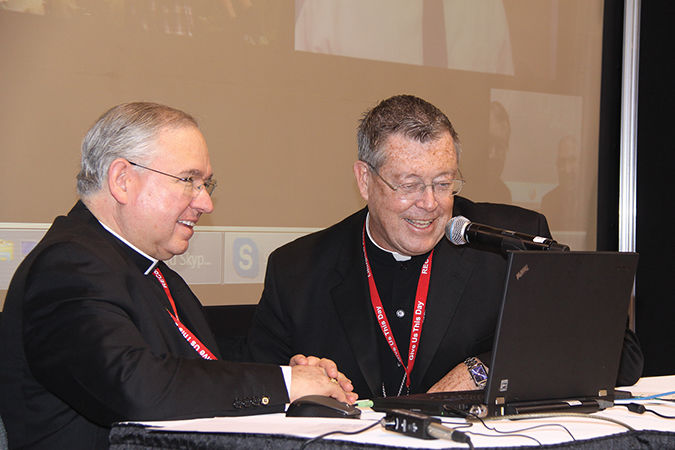If Christianity could be contained in one tweet, it might read: God creates man, man sins against God, God sends his only Son into the world to bring man back to Him.
It’s a difficult task to fit the entire Gospel into 140 characters or less. But that doesn’t mean the Church shouldn't try.
That was Archbishop José H. Gomez’s Aug. 16 message on media and the New Evangelization at the Catholic Association of Latino Leaders (CALL) conference in Houston.
In fact, he said, the Church can learn from the brevity of some of Jesus’ teachings and the prayers of early Christians when creating social media content.
“Jesus spoke in ‘brief’ but memorable forms,” the archbishop reflected. “Think about his beatitudes, his parables and his aphorisms. The Desert Fathers and early Christian monks used proverbs and short prayers drawn from the Psalms and the Scriptures.”
The concept of the Church employing the latest media to share the Gospel is not a new one, Archbishop Gomez noted. Evangelization has always been about communication, and technology has always helped further that mission, beginning with the printing press and continuing with radio, T.V. and the Internet.
For the 23rd World Communications Day in 1989, even before the internet was standard household technology, Pope St. John Paul II observed: “The question confronting the Church today in not any longer whether the man in the street can grasp a religious message, but how to employ the communications media so as to let him have the full impact of the Gospel message.”
That question remains relevant as technology continues to change and advance.
“We are living in the first generation where the Internet, computers, mobile phones and social networking media such as Facebook, Twitter and Instagram are a ‘given’ part of ordinary daily reality,” Archbishop Gomez said.
The way people think, express themselves, learn and form relationships are all affected by this reality, he said, and the Church must respond, seeing the media as an opportunity rather than as a challenge to the Gospel.
The archbishop himself has a Facebook page and a Twitter account, with about 235,000 and 14,000 followers, respectively.
“My goal is to make connections with my people, to build friendship and community, to address peoples’ spiritual needs, and to nourish their faith,” he said.
The Archdiocese of Los Angeles is employing a social media strategy with four goals: to provide news and information about the Church, to provide the Church’s interpretation of current events, to share Church doctrine and to defend and explain the Church’s teachings.
The Church must also be savvy when it comes to the culture of the “digital realm,” he said, recognizing that social media often makes use of brief snippets that tend to appeal more to emotions and experiences rather than arguments and explanations.
And despite the widespread secularization of today, social media reveals humanity’s need for connection and love, and ultimately their hunger for God.
“People are searching the social channels of the Internet for ‘answers’ and for spiritualities that will bring them holiness and wholeness and communion with God and other people,” he said, which is why social media must be “mission territory” for the Church.
However, all social media must be used as a means to an end — to help people encounter the living God, outside of the digital world.
“It’s all about bringing people to Jesus,” he said, so that they may “experience the reality of the living God who loves us, who forgives us, who cares for us like a Father. And this reality is only experienced fully in the Church and in the sacraments.”
CALL is a national organization dedicated to the growth and spiritual formation of the Latino leaders of this country in their knowledge and understanding of the Catholic faith.

